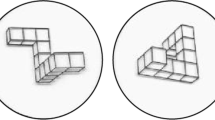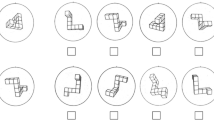Abstract
Performance differences in spatial abilities as a function of gender may be modified by practice and relevant background experiences, as well as by directions given in laboratory situations. We examined whether a focus on speed or accuracy influenced performance in various spatial domains, using several different scoring techniques. Men and women from a small, predominantly White private college completed tasks of spatial perception, spatial visualization, and mental rotation under one of three conditions: speed-emphasis, accuracy-emphasis, or control. Participants also provided information concerning experiences pertinent to spatial ability. Results revealed relative parity between men and women on tasks of spatial visualization and spatial perception; speed/accuracy orientation did not alter these findings. Men outperformed women on mental rotation, but only when scored in a strict manner and when explicitly told to focus on accuracy, but not when directional emphasis was absent or geared toward speed. Self-reported background in math, sports, and the arts was unrelated to performance. The results are discussed in terms of women's efficacy beliefs about performing tasks explicitly designated as spatial in nature.
Similar content being viewed by others
REFERENCES
Alington, D. E., Leaf, R. C., & Monaghan, J. R. (1992). Effects of stimulus color, pattern, and practice on sex differences in mental rotations task performance. Journal of Psychology, 126, 539–553.
Baenninger, M., & Newcombe, N. (1989). The role of experience in spatial test performance: A meta-analysis. Sex Roles, 20, 327–344.
Beatty, W.W., & Duncan, D. (1990). Relationship between performance on the Everyday Spatial ActivitiesTest and on the objective measure of spatial behavior inmenand women. Bulletin of the Psychonomic Society, 28, 228–230.
Beyer, S. (1995). Maternal employment and children's academic achievement: Parenting styles as a mediating variable. Developmental Review, 15, 212–253.
Beyer, S., & Bowden, E. M. (1997). Gender differences in self perceptions: Convergent evidence from three measures of accuracy and bias. Personality and Social Psychology Bulletin, 23, 157–172.
Bryden, M. P., George, J., & Inch, R. (1990). Sex differences and the role of figural complexity in determining the rate of mental rotation. Perceptual and Motor Skills, 70, 467–477.
Cooper, J., Hall, J., & Huff, C. (1990). Situational stress as a consequence of sex-stereotyped software. Personality and Social Psychology Bulletin, 16, 419–429.
Eagly, A. H. (1987). Sex differences in social behavior: A social-role interpretation. Hillsdale, NJ: Erlbaum.
Fouad, N. A., & Smith, P. L. (1996).Atest of a social cognitive model for middle school students: Math and science. Journal of Counseling Psychology, 43, 338–346.
Goldstein, D., Haldane, D., & Mitchell, C. (1990). Sex differences in visual-spatial ability: The role of performance factors. Memory and Cognition, 18, 546–550.
Halpern, D. F. (1986a). Sex differences in cognitive abilities. Hillsdale, NJ: Erlbaum.
Halpern, D. F. (1986b).Adifferent answer to the question, do sex-related differences in spatial ability exist? American Psychologist, 41, 1014–1015.
Halpern, D. F. (1992). Sex differences in cognitive abilities (2nd ed.). Hillsdale, NJ: Erlbaum.
Halpern, D. F. (1997). Sex differences in intelligence: Implications for education. American Psychologist, 52, 1091–1102.
Jacobs, J. E., & Eccles, J. S. (1992). The impact of mothers' gender-role stereotypic beliefs on mothers' and childrens' ability perceptions. Journal of Personality and Social Psychology, 63, 932–944.
Kail, R., Carter, P., & Pellegrino, J. (1979). The locus of sex differences in spatial ability. Perception and Psychophysics, 26, 182–186.
Kass, S. J., Ahlers, R. H., & Dugger, M. (1998). Eliminating gender differences through practice on an applied visual spatial task. Human Performance, 11, 337–349.
Kerns, K. A.,V & Berenbaum, S. A. (1991). Sex differences in spatial ability in children. Behavior Genetics, 21, 383–396.
Kimura, D. (1992). Sex differences in the brain. Scientific American, 267, 119–125.
Linn, M. C., & Petersen, A. C. (1985). Emergence and characterization of sex differences in spatial ability: A meta-analysis. Child Development, 56, 1479–1498.
Luehring, J., & Altman, J. D. (2000). Factors contributing to sex differences in the mental rotation task. Psi Chi Journal, 5, 39–35.
Lunneborg, P. W. (1982). Sex differences in self-assessments of everyday spatial abilities. Perceptual and Motor Skills, 55, 200–202.
Lytton, H., & Romney, D. M. (1991). Parents' differential socialization of boys and girls: A meta-analysis. Psychological Bulletin, 109, 267–296.
Masters, M. S. (1998). The gender difference on the mental rotations test is not due to performance factors. Memory and Cognition, 26, 444–448.
McGee, M.G. (1979).Humanspatial abilities: Psychometric studies and environmental, genetic, hormonal, and neurological influences. Psychological Bulletin, 86, 889–910.
Newcombe, N., & Bandura, M. M. (1983). Effect of age at puberty on spatial ability in girls: A question of mechanism. Developmental Psychology, 19, 215–224.
Newcombe, N., Bandura, M. M., & Taylor, D. G. (1983). Sex differences in spatial ability and spatial activities. Sex Roles, 9, 377–385.
Nisbett, R. E., & Wilson, T.D. (1977). Telling more than we can know:Verbal reports on mental processes. Psychological Review, 84, 231–259.
Oosthuizen, S. (1991). Sex-related differences in spatial ability in a group of South African students. Perceptual and Motor Skills, 73, 51–54.
Petrusic, W. M., Varro, L., & Jamieson, D. G. (1978). Mental rotation validation of two spatial ability tests. Psychological Research, 40, 139–148.
Räsänen, L. (1991). Girls and the learning of physical concepts. Finnish Journal of Education, 22, 185–194.
Resnick, S. M. (1993). Sex differences in mental rotations: An effect of time limits? Brain and Cognition, 21, 71–79.
Richardson, J. T. E. (1994). Gender differences in mental rotation. Perceptual and Motor Skills, 78, 435–448.
Sanders, B., & Soares, M. P. (1986). Sexual maturation an spatial ability in college students. Developmental Psychology, 22, 199–203.
Scali, R. M., & Brownlow, S. (in press). Impact of stereotype activation and experimental instructions on spatial performance. Psi Chi Journal.
Sharps, M. J., Price, J. L., & Williams, J. K. (1994). Spatial cognition and gender: Instructional and stimulus influences on mental image rotation performance. Psychology of Women Quarterly, 18, 413–425.
Sharps, M. J., Welton, A. L., & Price, J. L. (1993). Gender and task in the determination of spatial cognitive performance. Psychology of Women Quarterly, 17, 71–83.
Signorella, M. L., & Jamison, W. (1986). Masculinity, femininity, androgyny, and cognitive performance: A meta-analysis. Psychological Bulletin, 100, 207–228.
Stericker, A., & LeVesconte, S. (1982). Effect of brief training on sex-related differences in visual-spatial skill. Journal of Personality and Social Psychology, 43, 1018–1029.
Stumpf, H., & Kleime, E. (1989). Sex-related differences in spatial ability: More evidence for convergence. Perceptual and Motor Skills, 69, 915–921.
Swim, J. K. (1994). Perceived versus meta-analytic effect sizes: Assessment of the accuracy of gender stereotypes. Journal of Personality and Social Psychology, 66, 21–36.
Swim, J. K., & Sanna, L. J. (1996). He's skilled, she's lucky: A meta-analysis of observers' attributions for women's and men's successes and failures. Personality and Social Psychology Bulletin, 22, 507–519.
Tapley, S. M., & Bryden, M. P. (1977). Sex differences in mental rotation. Canadian Journal of Psychology, 31, 123–130.
Vandenberg, S. G., & Kuse, A. R. (1978). Mental rotations, a group test of three-dimensional spatial visualization. Perceptual and Motor Skills, 47, 599–604.
Voyer, D., Voyer, S., & Bryden, M. P. (1995). Magnitude of sex differences in spatial abilities:A meta-analysis and consideration of critical variables. Psychological Bulletin, 117, 250–270.
Walter, K., Roberts. A. E., & Brownlow, S. (2000). Spatial perception and mental rotation produce gender differences in cerebral hemovelocity: A TCD study. Journal of Psychophysiology, 14, 37–45.
Author information
Authors and Affiliations
Rights and permissions
About this article
Cite this article
Scali, R.M., Brownlow, S. & Hicks, J.L. Gender Differences in Spatial Task Performance as a Function of Speed or Accuracy Orientation. Sex Roles 43, 359–376 (2000). https://doi.org/10.1023/A:1026699310308
Issue Date:
DOI: https://doi.org/10.1023/A:1026699310308




